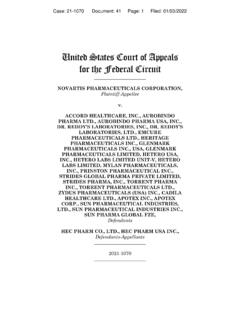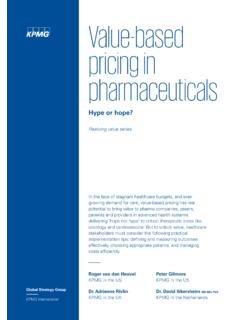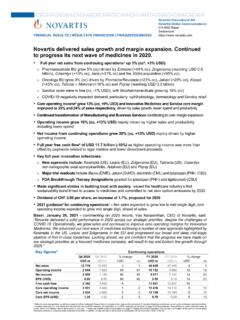Transcription of Procedure under Article 5(3) of Regulation EC (No) 726 ...
1 Official address Domenico Scarlattilaan 6 1083 HS Amsterdam The Netherlands An agency of the European Union Address for visits and deliveries Refer to Send us a question Go to Telephone +31 (0)88 781 6000 European Medicines Agency, 2020. Reproduction is authorised provided the source is acknowledged. 25 June 2020 EMA/369136/2020 Committee for Medicinal Products for Human Use (CHMP) Assessment report Procedure under Article 5(3) of Regulation EC (No) 726/2004 Nitrosamine impurities in human medicinal products Procedure number: EMEA/H/A-5(3)/1490 Note: Assessment report as adopted by the CHMP with all information of a commercially confidential nature deleted. EMA/369136/2020 Page 2/90 Table of contents Table of contents .. 2 1. Information on the Procedure .
2 7 2. Scientific discussion .. 7 7 Quality and safety aspects .. 7 Root causes for presence of N-nitrosamines in medicinal products and measures to mitigate 8 Presence and formation of N-nitrosamines in human medicinal products .. 9 Confirmed root-causes for the formation of N-nitrosamines in medicinal products with regard to excipients and as contaminants from primary packaging .. 21 Discussion on root causes and strategies to mitigate the presence of N-nitrosamines in human medicinal products .. 23 Consideration for analytical method development to identify and quantify N-nitrosamines in APIs and finished products .. 25 Analytical Methods .. 25 Sample Preparation Procedures .. 26 Potential causes of erroneous analytical results .. 28 Internal Standards .. 29 Advantages of mass spectrometric detection 29 Currently used methods in OMCLs.
3 29 Sensitivity of the analytical methods .. 30 Discussion on analytical aspects .. 31 Considerations for calculating risk for exposed patients in case of detection of N-nitrosamines in medicinal product(s) .. 31 Background exposure to N-nitrosamines .. 31 Mutagenicity and carcinogenicity of N-nitrosamines .. 35 N-Nitrosamine carcinogenicity in animals .. 37 Use of in vitro mutagenicity data for carcinogenicity potency ranking of N-nitrosamines .. 41 Generic methodology to calculate excess risk for humans .. 43 Literature review of epidemiological studies .. 44 Methodology for defining limits for N-nitrosamines .. 48 Limits for individual nitrosamines, for multiple N-nitrosamines and less than lifetime (LTL) approach .. 48 Limits for nitrosamines without sufficient substance specific 50 Other risk management approaches.
4 51 Comparison of different options for setting limits .. 52 Consideration for further studies .. 56 Consideration for further non-clinical/clinical studies .. 56 Consideration for further epidemiological studies .. 56 Relevance for the CHMP opinion on medicinal products containing sartans with a tetrazole 58 3. Expert consultations .. 59 Ad-hoc expert group .. 59 BWP consultation .. 64 EMA/369136/2020 Page 3/90 QWP consultations .. 64 Summary of QWP responses to first CHMP 64 Summary of QWP responses to second CHMP LoQ .. 65 SWP consultations .. 66 Summary of SWP responses to first CHMP LoQ .. 66 Summary of SWP response to second CHMP LoQ .. 70 PRAC consultation .. 71 4. Conclusions .. 73 Root causes for presence of N-nitrosamines .. 73 Analytical methods for N-nitrosamines.
5 74 Setting Limits for N-nitrosamines in human medicinal products .. 75 Presence of more than one N-nitrosamine .. 76 N-nitrosamines with insufficient toxicological data .. 76 Less-than-lifetime (LTL) approach .. 76 Considerations on epidemiological studies .. 77 5. Recommendations .. 77 6. References .. 82 EMA/369136/2020 Page 4/90 List of abbreviations AI Acceptable intake. In the context of this document, an intake level /limit associated with a theoretical excess lifetime cancer risk of 1:100,000 based on considerations in ICH M7(R1) for substances from the cohort of concern API Active Pharmaceutical Ingredient AIM Active Ingredient Manufacturer = active substance manufacturer ALARA as low as reasonably achievable ALARP as low as reasonably possible BCNU Bischloroethyl nitrosourea CCNU 1-(2-Chloroethyl)-3-cyclohexyl-1-nitroso urea CHMP Committee for Human Medicinal Products CPDB Carcinogenic potency database CoA Certificate of Analysis CoC Cohort of Concern Compounds CEP Certificate of Suitability to the monographs of the European Pharmacopoeia (CEP) CRS Chemical Reference Substance (official standard)
6 DIPNA N,N-diisopropylethyl-N-ethylamine DMF Dimethylformamide DI Direct injection DS Drug substance EDQM European Directorate for the Quality of Medicines EFSA European Food Safety Agency EIPNA Ethylisopropyl-N-nitrosoamine EMA European Medicines Agency ENOCs Endogenously produced N-nitroso compounds EPA Environmental Protection Agency FDA Food and Drug Administration IARC International Agency for Research on Cancer IPC In-process control IR Infrared Spectrometry IU International Units LCDB Lhasa Carcinogenicity Data Base LOD Limit of Detection LTL Less than Lifetime EMA/369136/2020 Page 5/90 LOQ Limit of Quantification MA Marketing Authorisation MAH Marketing Authorisation holder Methyl-CCNU 1-(2-Chloroethyl)-3-(4-methylcyclohexyl) -1-nitrosourea MGMT Methyl-guanine-methyl-transferase MNNG N-Methyl-N -nitro-N-nitrosoguanidine MS Mass Spectrometry ND Not detected NDBzA N-nitrosodibenzylamine NDEA N-Nitrosodiethylamine NDELA N-Nitrosodiethanolamine NDiBA N-Nitrosodiisobutylamine NDMA N-Nitrosodimethylamine NDPA N-Nitrosodi-n-propylamine NDPhA N-nitrosodiphenylamine NHMTC N-nitroso-2-hydroxymethyl-thiazolidine-4 -carboxylic acid NHPRO N-nitrosohydroxyproline NIAN 1-Nitrosoindole-3-acetonitrile NLT Not less than NMEA N-Nitrosomethylethylamine NMNU N-Methyl-N-nitrosourea NMOR N-Nitrosomorpholine NMP N-Methyl-2-pyrrolidone NMT Not more than NMTCA N-nitroso-2-methyl-thiazolidine-4-carbox ylic acid NMVA N-Nitrosomethylvinylamine NNK 4-(N-Nitrosomethylamino)-1-(3-pyridyl)
7 -1-butanone NNN N-Nitrosonornicotine NOC(s) N-nitroso compound NPIC N-nitrosopipecolic NPIP N-Nitrosopiperidine NPRO N-nitrosoproline NPYR N-nitrosopyrrolidine EMA/369136/2020 Page 6/90 NSAR N-Nitrososarcosine NTCA N-nitroso-thiazolidine-4-carboxylic acid NTHZ N-Nitroso-thiazolidine Ph. Eur. European Pharmacopoeia RH Relative Humidity RSD Relative standard deviation SAR Structure-activity-relationship SCCP Scientific Committee for Consumer Products SPC Summary of Product Characteristics TD50 Tumour dose 50 the daily dose causing tumours in 50% of animals in a life time bioassay TEA Triethylamine TTC Threshold of Toxicological Concern USDA United States Department of Agriculture USP/NF United States Pharmacopoeia/National Formulary UV Ultraviolet Spectrometry WFI Water for Injection WHO World Health Organization EMA/369136/2020 Page 7/90 1.
8 Information on the Procedure Building on the Article 31 referral on sartans with a tetrazole ring and the knowledge acquired on N-nitrosamines in medicinal products, EMA together with the EU Network and international partners has continued the review to identify if there are any consequences for medicinal products outside the class of sartans. Taking into account that N-nitrosamines have been found in sartans with a tetrazole ring but also in other API/medicinal products ( in some batches of pioglitazone and ranitidine) on 10 September 2019 the EMA s Executive Director initiated a Procedure under Article 5(3) of Regulation EC (No) 726/2004, and requested the CHMP to further investigate the issues at stake and to give a scientific opinion on considerations for MAHs for medicinal products for human use containing chemically synthesised active pharmaceutical ingredients on the identification of the possible presence of N-nitrosamine impurities in their medicinal products ( call for review , Phase I).
9 And all available scientific knowledge on N-nitrosamine impurities in human medicines containing chemically synthesised active pharmaceutical ingredients and their impact on the safe use of medicines. In this exercise the CHMP could seek the support of additional experts and stakeholders as needed. Such evaluation should include the need whether or not to broaden the scope, in a next phase, to products other than human medicines containing chemically synthesised active pharmaceutical ingredients (Phase II) Therefore the scope of this Procedure covers all medicinal products for human use authorised in the EU/EEA and UK, while the call for review above (phase I) is addressing medicinal products containing chemically synthesised active pharmaceutical ingredients, as well as biological medicinal products.
10 2. Scientific discussion Introduction Following the outcome of the Article 31 referral on sartans with a tetrazole ring1 and the knowledge acquired on N-nitrosamines in medicinal products, EMA together with the EU Network and international partners has continued the review to identify if there are any consequences for medicinal products outside the class of sartans. Taking into account that N-nitrosamines have been found in sartans with a tetrazole ring but also in other API/medicinal products in September 2019 the CHMP s opinion was sought by the EMA s Executive Director in accordance with Article 5(3) of Regulation (EC) No 726/2004 regarding the detection, management and prevention of presence of N-nitrosamines in medicinal products for human use. Quality and safety aspects Following the assessment of all available scientific knowledge on N-nitrosamines and their impact on the safe use of medicinal products this report addresses the following points: Quality 1 receptor-antagonists-sartans-containing- tetrazole-group EMA/369136/2020 Page 8/90 Root causes for presence of N-nitrosamines and proposed measures to mitigate it.















